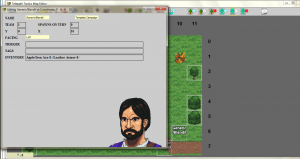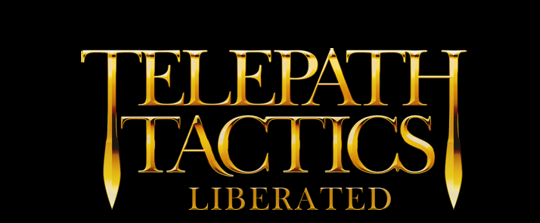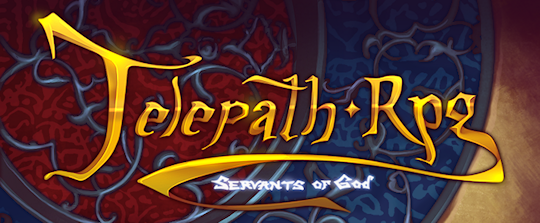Just yesterday, I finished patching out the last of the major issues in Telepath Tactics. Now seems like a good time to begin a second marketing push! For this reason, I’ve written the following article–aimed at the media, but probably of interest to others as well–explaining why this game is so important.
“Important?” you might say. “Come now, Craig, aren’t you being a little pompous?” No, really! Aside from just being a solid, well-designed strategy RPG on a platform historically lacking in such titles, there are six major things that–in my honest (if not objective) opinion–make Telepath Tactics genuinely special and worthy of greater attention.
1. The game is mostly deterministic.
I talked about the significance of this with Charlie Hall of Polygon, but I haven’t seen it get much discussion elsewhere yet. If you look at the long history of war games, they’ve been centered around dice-based play going all the way back to Baron von Reisswitz and Kriegsspiel in the 1810s. As the historical children of war games, RPGs have inherited this tendency. Modern RPGs rely heavily on die rolls (or more accurately, random number generation algorithms inspired by them) to generate tension by rendering the outcome of individual player actions unpredictable. Frankly, it’s a design crutch: take randomized results away from most RPGs, and you’ll find that their mechanics are hollow and profoundly dull.
Telepath Tactics does not rely upon such cheap tricks to generate tension–instead, it provides a huge possibility space and an AI clever enough to take advantage of that space. This obscures the optimal move in any situation, building tension through uncertainty about what your enemy is going to do on future turns.
The result: a tactical battle system every bit as thrilling as what you get in a system heavy on randomization, but without compromising player control. The lion’s share of the tension comes from not being able to predict what the AI is going to do rather than from not knowing if individual attacks are going to hit (or deal certain amounts of damage when they do).
Before I wrote this 2012 article, virtually no tactics games were trying a deterministic approach like this, and the approach remains extremely uncommon even now. I consider Telepath Tactics a vindication of the design philosophy promoted in that article. The game’s core determinism has some really cool effects on players: it impacts their willingness to internalize losses as failures of their own strategy, as well as their will to keep plugging away obsessively with attempt after attempt at difficult battles. When you can’t pin a loss on getting screwed by the proverbial dice, you’re more willing to take responsibility for the result and try harder. And because this game has such a huge variety of available tactics, the room for trying out different approaches is ample indeed.
Telepath Tactics represents a huge paradigm shift in RPG combat design–that alone makes the game worth your attention.
2. The game is moddable.
I’ve heard people refer to Telepath Tactics as “RPG Maker for strategy RPGs” repeatedly. And to an extent, that’s true: you can create just about any kind of strategy RPG campaign you want in this game. Some of the things you can create or modify:
- character sprites and animations
- characters and character classes
- character portraits
- destructible objects
- tilesets
- attacks
- items
- effect animations
- UI graphics
- sound effects
- cut scenes
- dialogue trees
- scripts (there are more than 100 supported script actions that hook into the game’s code, with support for custom variables–which basically means that you can program a lot of really interesting stuff)
- multiplayer battles
- single player campaigns
 And what’s more, all of this is exhaustively documented in the game’s manual and explored in an online tutorial series so as to make modding as painless as possible. And if that wasn’t enough, Telepath Tactics comes with an easy-to-use map (and dialogue tree) editor!
And what’s more, all of this is exhaustively documented in the game’s manual and explored in an online tutorial series so as to make modding as painless as possible. And if that wasn’t enough, Telepath Tactics comes with an easy-to-use map (and dialogue tree) editor!
This level of mod support is almost unheard of in the strategy RPG genre, and for good reason: strategy RPGs cater to a niche market. They rely on a certain scarcity of content to maintain demand, feeding their players a new scenario every few years or so. This is the approach we observe in the Fire Emblem series, which sees a new release every 1-3 years like clockwork; likewise for Disgaea.
You might think that this would have changed with Kickstarter and the rise of indie sRPGs, but nope! The drip-feed approach is even more prominent in Kickstarted titles. The Banner Saga and Unsung Story, for instance, are each episodic, requiring the player to wait years and purchase multiple titles to see even a single storyline wrapped up.
Telepath Tactics avoids the drip-feed and instead leads players straight to the water source. While I’m not averse to releasing new Telepath Tactics titles later down the line, the game is specifically designed so players won’t have to wait for me to do so–all they have to do is download someone else’s campaign, stick it in the User Campaigns folder, and voila: there’s a whole new campaign available for them to play.
3. The game has local multiplayer.
Do you know which strategy RPGs have competitive local multiplayer? It’s an exceptionally short list. There’s Telepath Tactics and The Battle for Wesnoth, and…that’s actually it.
Okay, that’s not entirely fair: Fire Emblem did dabble in local multiplayer at one point, but it was such a massive disappointment that I don’t think we can really count it in good conscience. Imagine how ecstatic GBA-era Fire Emblem players were when they learned that upcoming games were going to support head-to-head link multiplayer. Finally, they’d get a chance to pit their tactical wits against their friends! And you can only imagine the crushing disappointment they felt when these same fans learned that the multiplayer mode was nothing more than repeatedly selecting one out of five characters and having the selected character go head-to-head against one other character for a single round of combat. With no use of terrain, positioning, or items, it resembled a stripped-down Pokemon match more than it did anything like a strategy RPG battle:
There’s none of that nonsense in Telepath Tactics. The local multiplayer mode in Telepath Tactics supports up to 6 armies on the same battlefield, with characters drawn from 23 distinct character classes, multiple game types, and loads of rules customization. It even has random item drops a la Super Smash Brothers!
While there are many strategy RPGs out there with internet-only multiplayer, Telepath Tactics offers the simple fun of getting together with your friends in the very same room and playing out tactical turn-based battles on your computer. Just hook your laptop up to the TV with an HDMI cable and you’re set! I’ve tried it on multiple occasions; it’s a great time.
What’s more, multiplayer has the same level of mod support as the single player game! There are people on the forums churning out new multiplayer maps and rulesets for Telepath Tactics as I write this.
I’m honestly a bit surprised that I haven’t seen strategy Youtubers and Twitch streamers scrambling to try this out yet–Telepath Tactics multiplayer has the potential to offer a nearly endless source of thrilling, fresh gaming content. Why not give it a try?
4. The game’s politics are unusual.
A lot of people either don’t care about the politics inherent to video game stories, or else deny that creative works have politics to begin with in the absence of creator intent. If that sounds like you, well, this part is probably going to bore you to tears–feel free to skip down to Reason 5. For the rest of you, however, buckle up: we’re gonna talk politics!
It has long been my position that games–just like any other art form–suggest things to those who engage with them. The only difference is that games are even more potent. Games symbolically represent a world, characters, and systems, and the player must mentally model them in order to interact successfully and meet their goals within the game world. Over time, this mental modeling can condition a player to reflexively employ those ways of thinking outside of the game space.
As a developer, I take this stuff seriously, and so I make an effort to act responsibly when I construct my characters and themes. Consequently, Telepath Tactics consciously sidesteps the traditional politics of the strategy RPG genre, which are seldom all that progressive.
Let’s look at class politics to start with. RPG class politics tends to be stuck in the Middle Ages; and I mean that literally. It is extremely common for RPG protagonists to be stuck doing the bidding of a medieval-style monarch. It’s even worse in the strategy RPG subgenre, where the protagonists themselves are typically kings or aristocrats defending (or even expanding!) their landed holdings against enemy kingdoms.
With the sole exception of Path of Radiance and Radiant Dawn, every last Fire Emblem features either a prince (Marth, Chrom, Roy, Ephraim, etc.), a princess (Eirika), or other members of the nobility as protagonists. As players, we’re expected to identify with the ruling classes in these games. And just to be extra unsubtle about it, the latest Fire Emblem apparently features “Marx” as the hero of the ethically suspect Black Kingdom. Hoo boy. [Note: “Marx” was later renamed to “Xander” for the English language localization of the game, presumably to sidestep these exact connotations.]
It’s not just Fire Emblem, either. Disgaea and Disgaea 3 feature princes seeking to amass power. The default hero of classic Sega CD sRPG Dark Wizard is a prince; another acts under orders from the king. Shining Force and Shining Force 2 see you acting under direct orders from the king; the first two-thirds of Shining Force 3 have you playing as a lord and prince, respectively. Massive Chalice puts you in the role of an immortal king. SSI’s classic sRPG Sword of Aragon is downright imperialist: not only do you play a king, you play one whose whole goal is to conquer neighboring kingdoms and create an empire!
In short, protagonists in these games are overwhelmingly kings, princes, and people tasked with carrying out the will of kings and princes. These are games about the upper classes, and their plot lines mirror that focus. They present war stories where the protagonists have a personal stake in the fate of the country precisely because they are the individuals in charge of said country. To the extent that commoners appear in the story, they appear as servants, pawns, allies, or as props waiting to be saved by the heroic political elites.
Telepath Tactics averts this tendency entirely. It takes place in a portion of the world ruled by a republic. Its protagonists are people without wealth, land, or title. Instead of presenting yet another story of conquest, Telepath Tactics focuses on the dehumanization and exploitation of common people by private industry. Rather than spending its time romanticizing the bloody wars of the ruling classes, it touches on themes that are actually germane to most players’ lives.
But why stop at class politics? Telepath Tactics also has unusual gender politics. You surely don’t need me to recount the litany of regressive gender tropes that abound in games generally, with RPGs in particular suffering from the overuse of tropes such as the Damsel in Distress and Guys Smash, Girls Shoot.
Compared to other subgenres under the RPG umbrella, strategy RPGs are (absent a few flat-out embarrassments like Record of Agarest War) actually pretty good in terms of representing women and giving them agency. There are some slip-ups, though. Fire Emblem: Genealogy of the Holy War makes prominent use of damseling, and strategy RPGs in general frequently employ variants on Guys Smash Girls Shoot (it wasn’t until Path of Radiance that Fire Emblem even allowed female characters to ride wyverns or use axes as their primary weapon; Disgaea gives male characters higher strength and a longer throw distance, but lower agility; and so on).
Telepath Tactics doesn’t merely avoid a lazy reliance on gender stereotypes, however: it actively takes gender-related tropes and flips them around. A sampling:
- Telepath Tactics takes the now-standard damseling plot about fathers going to rescue their wives/girlfriends/daughters and turns it on its head. The two main protagonists in Telepath Tactics are sisters whose main quest is to rescue their father.
- Telepath Tactics averts the age-old tendency to make male protagonists the front-line fighters while relegating women to support roles. In Telepath Tactics, the main front-line fighters are almost entirely women.
- In most RPGs, the cast of protagonists is predominantly male with a handful of women thrown in; in Telepath Tactics, the playable cast is predominantly female.

- In most RPGs, women’s character arcs tend to revolve around romances with men, or around avoiding unwanted marriages to them; this is our beloved genre’s favorite way of flunking the Bechdel test. In Telepath Tactics, women’s relationships with each other are front-and-center, and drive most of the game’s character development.
- In most strategy RPGs, the player faces overwhelmingly male enemies; here, non-unique characters have their gender assigned at random. (Every single character class in the game comes in both male and female versions, save for the genderless Golems.)
Significantly, the game never explicitly calls attention to any of this. I think that’s important, because subverting all of these tropes without the game making a huge deal about doing it normalizes the treatment. (If I were to call attention within the game to how unusual all of this is, that would effectively just reinforce the original stereotypes by asserting their normalcy.)
I’m just scratching the surface here. There are a number of critics out there doing really interesting work exploring the politics of video games. Suffice it to say I would be delighted to see some of them critique Telepath Tactics.
5. The game’s world is unusual.
The Lord of the Rings was published in 1955. That was 60 years ago, and RPGs have been steadily plagiarizing J.R.R. Tolkien ever since. If I had a dollar for every time I had to fight an orc or a giant spider in an RPG, I could retire wealthy; if I received an extra dime for every time I had the choice of playing as a human, an elf, or a dwarf, I could buy a small island to live out said retirement on.
 What I’m saying is, I’m bored to death of fantasy settings simply rehashing the exact same fantasy ad infinitum. The Telepath universe gets away from that over-familiar stuff and into things that are just a little more…weird.
What I’m saying is, I’m bored to death of fantasy settings simply rehashing the exact same fantasy ad infinitum. The Telepath universe gets away from that over-familiar stuff and into things that are just a little more…weird.
The world has no horses, for one thing. Gigantic mantises and scorpions are the world’s mounts of choice, as well as a popular choice for pets. All of the sentient non-human species that appear in Telepath Tactics (such as the lissit, the spriggats, and the shadowlings) are exclusive to the Telepath universe, with their own unique histories and roles. The world of Telepath features steam technology, but none of the other trappings of Victorian England typically associated with “steampunk. ”
Also significant is the fact that there is no magic, only various disciplines of psionics. Writing stories in a setting without magic presents a particular challenge. RPGs with magic can explain inconsistencies with nonsensical magical MacGuffins and by resort to A Wizard Did It; the Telepath universe allows for no such luxuries. Because nothing can be explained away by magic, there are limited opportunities for hand-waving, and everything must make sense in itself.
Telepathy’s primary role in this world is to explain the ongoing mystery of the strategy RPG genre: how it is that we can always see the enemies and know so much about them, from their health to their elemental resistances to the items they’re carrying? Generals in this world are often trained telepaths (or in rare instances, untrained ones). This focus on psionics also opens the door to a lot fun and unusual abilities, like telekinetically throwing enemies into lava, creating hallucinatory decoys, and temporarily gaining control of an enemy’s mind and manipulating them as if they were your own.
This strange, fantastical setting hasn’t been easy to market, since there isn’t an easy catch-phrase available that properly expresses it all (“high fantasy”, “low fantasy”, “steampunk”, “cyberpunk”, etc.) While that’s bad for marketing, I believe that makes Telepath Tactics a much more compelling game–and I’d love to see that get more attention.
6. The game’s narrative scope is intimate
RPGs these days are constantly giving us plots about winning massive, hopeless wars and preventing world-ending cataclysms. The stakes in these stories are huge, which might seem like a benefit, but there is a cost to going this route: the stakes are also hugely impersonal. When the consequences of failure are “the world literally ends,” you can swap in pretty much any other character who isn’t suicidal and they would do more or less the same things that your protagonists do. They become helpless puppets, running from MacGuffin to MacGuffin because It’s The Only Way to Save The World. Your characters don’t drive the plot in these scenarios–the plot drives them. They’re just the poor bastards who happened to draw destiny’s short straws.
As I wrote back in 2012:
The industry’s single-minded obsession with the epic has grown tiresome, in no small part because it overshadows the importance of more intimate approaches in games. Difficult and contentious issues that actually matter to peoples’ lives are abandoned in favor of empty conflict. Nearly across the board, game stories have largely become exercises in recycling the same weary jumble of tired hero’s journey tropes, employed without focus or ambition.
In recent years, the alternative to the epic story has been to have no story at all: the player must survive, and that is all. (Hence, the rise of the “survival RPG.”) This is a way of sidestepping the linearity of our tiresome “save the world” plot, but it’s not any more interesting from a narrative standpoint: the stakes are still “you’re going to die–go do things so you don’t.”
Instead of having the player merely keep their character alive or shepherd around the “chosen ones” du jour, I have elected to have the player direct protagonists with both agency and intact memory, such that the story is actually driven by their singular motivations. This isn’t entirely unheard of in RPGs, but it certainly isn’t very common either. Exploring that alone would make for an interesting article, I think.
Conclusion
To review: Telepath Tactics (1) is deterministic (rare in RPGs); (2) offers mod support (almost unheard of in sRPGs); (3) offers real local multiplayer (just about unheard of in sRPGs); (4) flips common class and gender tropes on their heads (rare in RPGs); (5) offers a genuinely unusual fantasy setting (rare in RPGs); and (6) eschews typical RPG plots in favor of something intimate and character-driven.
Thus, even though Telepath Tactics employs a familiar overall structure, it manages to break a lot of new ground within that structure: in its mechanics, in its features, and in its narrative. This is a game worth playing–and if you’re a member of the media, worth covering.
Craig Stern is the writer / designer / programmer behind Telepath Tactics–to get in touch with him, send him an email. He’ll get back to you quickly! (You can also find him on Twitter, if you’re into that sort of thing.) Go here for the Telepath Tactics press kit.





